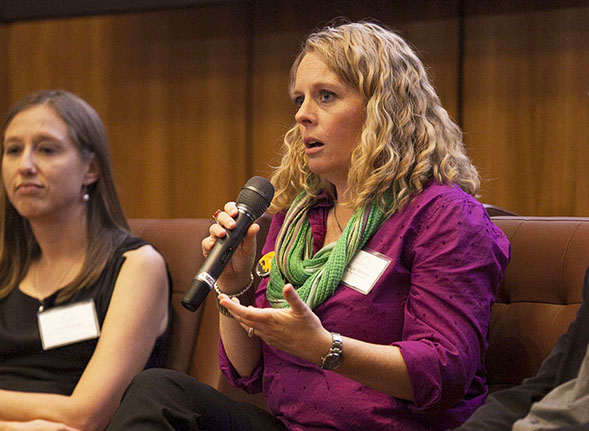SDSU Ecologist Heads Regional Climate Summit
Megan Jennings brought together climatologists and ecologists to forecast the future of San Diegos plants and animals under a changing climate.

“Often, ecologists and climate scientists do our separate sciences, and we thought it would be a great idea to work together and synthesize our knowledge.”
San Diego has long been envied for its friendly climes and eye-catching scenery, but its future—and that of the creatures who call it home—is an uncertain one under climate change. To help provide answers to many of the questions surrounding the impact of San Diego’s changing climate on the region’s plants and animals, San Diego State University ecologist Megan Jennings helped organize the 2018 San Diego Climate Summit held earlier this week at the Scripps Institution of Oceanography.
The summit, which was co-sponsored by SDSU, represented a rare opportunity to bring together both climatologists and ecologists to share knowledge, identify information gaps and discuss opportunities for collaboration.
“Often, ecologists and climate scientists do our separate sciences, and we thought it would be a great idea to work together and synthesize our knowledge,” said Jennings, who was honored at the event with the Climate Adaptation Leadership Award, presented by the Climate Science Alliance.
Over the past year and a half, more than a dozen scientists worked to drill down into San Diego’s regional climate forecasts over the next several decades and try to predict how that might affect the region’s plants and animals. The climatologists all came from Scripps, while Jennings organized a team of ecologists from various San Diego research institutions. Besides Jennings, SDSU was represented in the work by field botanist Sula Vanderplank.
San Diego is a “biodiversity hotspot,” Jennings explained, with a number of factors that make it a unique environment: The diverse region encompasses coastal, desert, riparian and mountain ecosystems. Thousands of acres of conserved land abuts developed, urban habitat. Rainfall is extremely variable from year to year. And a number of smaller-scale community conservation plans already exist.
The ways in which shifting climate and rainfall patterns plays out in concert with development pressures and habitat loss and conservation will gravely affect the more than 200 species in the region that are listed as rare, endangered or sensitive.
The region’s rainfall is projected to become even more variable, with more dry years intermittently punctuated by extremely heavy flooding events. Drought may become more frequent and more extreme, the researchers noted at the summit. Longer dry spells and Santa Ana winds occurring during dry fall months could mean increased risk of wildfires. And San Diego’s iconic marine layer, which buffers warming and drying along the coast, might occur less frequently in the future.
What does that mean for wildlife and ecosystems? Jennings noted that San Diego’s coastal sage scrub ecosystem, for example, provides a critical home for the threatened California gnatcatcher bird. Yet the prospect of a drier, warmer climate, plus increased urban and suburban development, risks destroying much of this important ecosystem.
The team of climatologists and ecologists summed up its findings in an executive summary and presented it at the summit, which was attended by hundreds of public officials, policymakers and natural resource management professionals. Jennings noted that the report does not support any particular policies, but it offers suggestions for climate adaptation planning.
Later this year, a more technical and detailed version of the report will be rolled into California’s Fourth Climate Change Assessment, a forthcoming statewide appraisal of climate change risk and preparedness.
“We wanted to make sure San Diego was well-represented in the assessment,” Jennings said.



